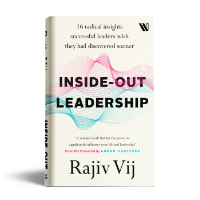
Photo by h.koppdelaney
I have been writing about the relevance of the journey of self-awareness and personal mastery – a journey that requires us to better understand and work with our personal emotional, mental and spiritual make-up. Among the various psychological and spiritual growth tools that can support us in this journey, many people find meditation to be one of the most effective ones. In that context, I thought of writing this blog piece to briefly introduce some key facets of meditation, its benefits, and share some thoughts based on my learning and experiences in this space.
Meditation is defined as engaging in a mental exercise towards reaching a deeper state of relaxation or awareness. It originated from the Latin word meditatio, meaning contemplation. People engage in meditation for a whole host of varied psychological and spiritual reasons – higher mental peace and relaxation, reducing anxiety or stress, boosting self-esteem, strengthening the mind, sharpening focus, enhancing creativity, and achieving higher states of self-awareness. While it has some definite background in religious upbringing, meditation can easily be a non-religious and purely spiritual exercise. However, in all situations, it tends to lay emphasis on direct experience rather than on any dogmas or beliefs.
Benefits
Significant quantum of research is now available on the benefits of meditation. Starting with studies on the Transcendental Meditation (TM) technique in the late 1960s, various research findings have shown that meditation practice can noticeably improve all aspects of an individual’s life – health, relationships, work productivity, creativity and even academic performance of children. Independent studies at the National Institute of Health, and at Harvard, reported that regular meditation reduces chronic pain, anxiety, high blood pressure, cholesterol and cortisol (the stress hormone). Research has demonstrated that during meditation, the metabolic rate and oxygen intake drops significantly. Also, the meditators’ levels of anxiety and tension, as measured by their skin resistance to an electrical current, have been found to decline. Meditation is also proven to increase serotonin production which influences mood and behavior. Low levels of serotonin are normally associated with depression, obesity, insomnia and headaches.
Similarly, other studies have demonstrated that sustained meditation practice can help business -and other leaders- build greater foresight, clearer thinking, authentic relationships, and enhance their productivity. Furthermore, children are proven to improve in their academic performance, creativity, and self-esteem through meditative practices. Meditation supports an individual’s growth of self-confidence, calmness, and tolerance. Such personal transformation at the deepest level also has a ripple effect in their environment – peaceful thoughts, speech and actions, developed by meditating individuals, lead to greater harmony not only in their immediate relationships, but also in the broader society.
How does it work?
Two key things that occur during meditation are a quieter mind and a greater focus on the present. Meditation generally requires pointed focusing on something and this forces the mind to stop getting entangled in the day-to-day challenges and worries. With greater practice, the number of thoughts arising in one’s mind during any given time also reduces – thereby, quitening the mind. Further, the pointed focus also requires focusing on the present moment. There’s a common emphasis across different practices to work on acknowledging and letting go of any other thoughts that may arise – this takes the mind away from living with the regrets of the past and anxieties of the future. A quieter mind, focused on the present, results in a higher level of awareness and a unique state of restful alertness.
Further, meditation can also facilitate positive physical changes in the brain. Until the 1980s, neuroscientists believed that an adult human brain had limited capacity to change. However, more recent research has established the concept of neuroplasticity – the idea that the brain is constantly evolving and forming new neural connections, based on its training and experiences. Meditation increases brain activity in an area of the brain associated with happiness and positive thoughts and emotions, and some evidence shows that regular practice brings prolonged positive changes in these areas.
Types of meditation
There’s a multitude of meditation techniques available and practiced by different people, ranging from focusing on breathing, or on an external object to visualization and chanting mantras. To keep it simple, I would like to categorize them all in what I find to be two of the broadest categories, namely – visualization and mindfulness.
Visualization techniques focus on building a deeper understanding of our desired state and then visualizing it to be manifesting in our life. The desired state could be related to any aspect of our life like, better physical health, stronger relationships, lower stress, greater effectiveness at work and so on. The underlying principle of visualization based techniques is that we create our own reality based on our intention, attention and actions. When we pay greater attention to negative thoughts (I am not that smart, or I never seem to do well, or I am always unhappy, and so on), we are perpetuating these manifestations by letting our body-mind act out these very thoughts. On the other hand, when we intend to move towards our desired state, and start paying attention to positive thoughts towards the future state (I am becoming smarter, I am beginning to or really doing well, and I am always happy), our body-mind sends out corresponding signals to the universe and that helps us create that state. There are countless success stories from the use of these techniques from all areas of life, including from sports where a number of sportsmen use this technique to great results. Examples of this approach include Reiki, SilvaUltramind system, Holosync audio meditation, and various affirmation techniques.
Mindfulness techniques, on the other hand, are generally related to focusing our entire attention to a specific thing. This may involve focusing on an external object or reciting a mantra (such techniques are generally referred to as concentration techniques) or focusing on our breathing, thoughts, feelings or sensations (more specifically referred to as mindfulness techniques). The broader principle behind these techniques is to observe the true nature of things – see things as they really are. These techniques help focus and sharpen the mind and that leads, firstly to deeper mental and physical relaxation, and secondly to a greater ability to observe and comprehend the true nature of things. A number of Buddhist meditation techniques (including Anapana, Vipassana, Metta and Zen meditations), Raja Yoga and TM are examples of this approach. I hope to describe these two broad techniques in greater detail in the next two blog posts respectively.
Endnote
Meditation serves different purposes for different individuals. For many, meditation is a spiritual practice – a way to journey within ourselves, to ultimately find the source of our very existence and universal intelligence. As Upanishads, the ancient Indian spiritual texts, describe the process of meditation on the self – “The self is the witness of the mind…it is not thought, but the thinker we must know. It is not what is seen, but the seer which must be known.” We are used to observing the object; here we need to observe the subject itself – in a way, it is like knowing the screen on which the thought images appear. For others, it may be a practice towards experiencing greater relaxation, peace and harmony. At the same time, when we examine the key facets of meditation like a quiet mind, focus on the present, and a sense of relaxed alertness, there many may be several other experiences in our lives that lead to a similar sense of flow – activities like painting, gardening, yoga, sewing, writing, and other creative pursuits. Now, for starters, it may be a useful discipline to create dedicated time for meditation on a daily basis. Simultaneously, it’s also worth noting that we always have the opportunity to be mindful of our thoughts and actions, learn to let go and be absorbed in the present moment and thereby, experience being in meditation throughout the day…irrespective of what we are engaged in.
Related Search terms:
how to do meditation /benefits of meditation /meditation for beginners /best meditation techniques











 Shifting From Transactional To Transformational Conversations
Shifting From Transactional To Transformational Conversations The Most Fascinating Movie of Our Lives!
The Most Fascinating Movie of Our Lives! The Grand Illusion!
The Grand Illusion! Are you the Aggressor or the Victim?
Are you the Aggressor or the Victim?
Very thoughtfull post on creative visualization.It should be very much helpfull
Thanks,
Karim –
Positive thinking
Rajiv, that is beautiful.
Particularly like your interpretation of meditation to include mindfulness.
Neat write up!
sunita